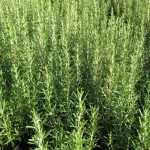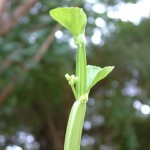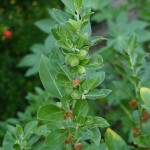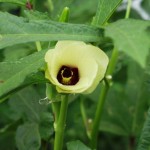Snail Cultivation (Heliciculture)
Even today, snail cultivation has got a very real economic significance. In France alone, 40,000 tonnes of snails are eaten per year. A large part of those are, even today, snails picked in nature and imported from Eastern Europe and Turkey. From an ecological point of view this is intolerable. From the consumer’s point of view it also is, because those snails are not retraceable. Nobody knows where exactly they come from, sometimes not even what kind of snails they are.
Continue reading
Chicory cultivation methods and environmental conditions
Chicory vegetable
Breed: politicians Curry
Differentiation of leaves are easy to grow as Chicory for greens wrapping called ssam in Korea
Characteristic
– Leaves is zignag, green, somewhat sharp shape
– Slightly bitter taste and very good taste as greens
Rayibel Rosemary Herb cultivation methods and environmental conditions
Rayibel Rosemary Herb
Varieties: rayibel Rosemary (herbs)
Scientific name: Rosmarinus officinalis
Origin: Mediterranean
All year round Meaning: good memories
Characteristic
– Proper germination temperature: 20 to 25 degrees
– Keys grew up about 1.5 meters, about 2-4cm, while headed becomes two peaks
– Flowers bloom throughout the winter-spring, white, purple, pink, purple, varying in – Started three years flowering
– A strong perennation even in Cold (-5 ‘C ~ 0’C) Continue reading
Mini tomato cultivation methods and environmental condition
Agronomic characteristics
Name : Cherry tomato
Scientific name: Lycopersicum esculentum MILL.
Growth temperature:
– Budding condition: 25 ~ 30 ℃
– Seedling condition: 20 ~ 25 ℃
– Flowering condition: 20 ~ 25 ℃
– Growing condition: 17 ~ 27 ℃
– Gwabidae condition: 25 ~ 30 ℃
– Save condition: 4 ℃
– Cultivated soil acidity, considerable growth in the range of pH 6.5 ~ 7.0 Good Continue reading
Cultivation Methods of Cissus Quadrangularis
Cissus Quadrangularis is a wild plant found in India, South Africa and in hot regions. These plants are not usually cultivated but due to the demand of the plants for medicine its now cultivated in some parts of the world.
Description of the Plant
Its node has a distance of 15cm and joined together. If the plant is planted in irrigated areas you will find more leaf and tendril than non-irrigated areas. When the plant is full grown, flowers start to appear and one seed is formed on each pod.
Cultivation Methods
Cissus Quadrangularis are mainly propagated by cuttings. The plants are cut between the two nodes 30 cm and dipped in cow dung slurry and dried in the sun for one day. The next day the plant can be planted in the prepared pits. A pit of 15×15×15 cm spacing at 5 ft is made. Fill the pit with one part of Vermi-compost one part of dry cow dung, one part of sand and one hand full of bone meal. Mix the same and fill the pit. The plants which are dried can be planted in the pit. Water the plants. See the plants are planted in straight line in both direction of the field. For first 15 days Cissus Quadrangularis should be watered every alternate days after that only once in every four days (hot climate). Never allow water to stage near the plant. Continue reading
Cultivation Methods of Withania Somnifera
English Name
Winter cherry
Assamese Name
Ashwagandha
Hindi Name
Punr, Chiropotan
Kannada Name
Kanchuki
Malayalam Name
Amukkuram
Marathi Name
Ghoda, Tilli
Telugu Name
Vajigandha, Pannirugada
Gujarati Name
Ghodaasun
Tamil Name
Akavu, Allivatli
Tibetian Name
Ba-dzi-ga-ndha
Withania somnifera, also known as Ashwagandha, Indian ginseng. Withania Somnifera belongs to the family of Solanaceae (Potato family). This plant is an erect herbaceous, evergreen shrub of 13 to 150 cm (4 to 5 ft). The stems are covered with whitish colour, stellate hairs. The leaves are ovate entire, thin. The flowers ate bisexual garnish or cured yellow, axillary in clusters of about 25 forming cymes, sessile.
Soil
The crop can be grown on a variety of soil but, it grows in sandy loom or literate soil with good organic matter and drainage. If the soil is loose it will be easily to dig the root out without damaging them. pH range of 7.5 to 8 is ideal for Withania Somnifera cultivation. Continue reading
Cultivation Methods of Abelmoschus Moschatus
Abelmoschus Moschatus is an annual growing plant in many hotter parts of the world. The seeds root and leaves are having different uses. The seeds contain fixed oil a solid crystalline matter and resin. Fixed oil is greenish yellow fluid which solidifies on contact with air.
Land is prepared by ploughing and leveling. Decomposition is applied and mixed well. Ridges and furrows are opened keeping a spacing of 60cm. Treat the seeds with “captain” at the rate of 6gm per Kg of seeds. Seeds are soaked in water for 24hrs and 2 seeds are sown one – one side of ridges at a depth of 1cm covered with soil. The field is irrigated soon after sowing. After 6 to 12 days of germination, nitrogen is applied in furrows about 10cm away from the plants.
Irrigation
During the first stage the field is irrigated at 2-5 days interval and later stage once in a week depending on the weather conditions. The field is kept free from weeds and regular weeding is required during the growing period. Continue reading





